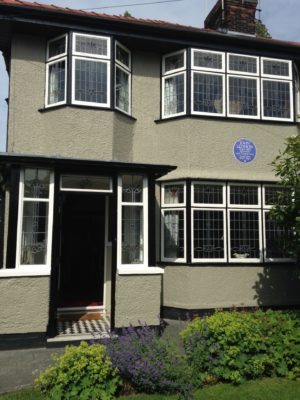John Lennon Slept Here: Looking for Fans in Public History
02 June 2020 – Nicolette Rohr
rock history, commemoration series, archives, historic preservation, commemoration, popular culture, music history
As I stood in a small room on Menlove Avenue in Liverpool, England, that had belonged to John Lennon, I bopped my head along to the Del-Vikings song playing, looked out at the blue suburban skies, and imagined John Lennon there, doing his dreaming, in this room at his Aunt Mimi’s. A fellow traveler, a woman in her sixties who was visiting from the United States with a friend, remarked that it had been her teenage dream to be in John Lennon’s bedroom. The National Trust tours of John Lennon’s and Paul McCartney’s homes, the only way to enter either site, are naturally about the two artists and their families. But standing next to these first-generation Beatles fans, I wanted to hear their stories too.

“Mendips,” John Lennon’s childhood home, shared with his Aunt Mimi and Uncle George, photographed in 2015. This Liverpool home on Menlove Avenue is accessible only by reservation on a National Trust tour that includes the McCartney family home on Forthlin Road. Photo credit: Nicolette Rohr
Traveling from Liverpool to L.A.—and places in between—exploring the public history of popular music, I’ve often felt that I’m where the fans are, making pilgrimages to music they love. But I’ve also noticed that I was where the fans aren’t, because their stories are often missing from the histories being shared. The past decade of commemorations and fiftieth anniversaries of the 1960s and of Beatlemania, Monterey, and Woodstock, have too often focused on famous names and faces, re-telling familiar stories to people who are likely to know them already. For instance, Ladies and Gentleman…The Beatles, a traveling exhibition curated by The GRAMMY Museum® at L.A. LIVE and Fab Four Exhibits, launched in 2014 to coincide with the fiftieth anniversary of the Beatles’ arrival in the United States and the peak years of Beatlemania, the term used to refer to the pandemonium and intense, often public, reactions of Beatles fans, many of them women. Although the British press coined the term during the first wave of fandom, Beatlemania was a significant part of American culture, especially during the years the Beatles toured the United States (1964-66). The exhibition conveyed the scale and wider cultural influence of the Beatles and displayed artifacts of fandom including shirts, socks, lunch boxes, and even ticket rejection slips disappointed fans received from The Ed Sullivan Show. But for an exhibition of Beatlemania, it focused (surprisingly) more on the Beatles than their fans. As is often the case, the voices of fans themselves (with the exception of a famous few), the experiences of fandom, and the stirrings of gender and generational rebellion it signaled were largely missing. I wondered how all of our understandings of this history would be different if their voices were centered in exhibitions like this one.
The star-centric approach is understandable. Fans book their tours of historic homes, storied venues, recording studios, and museums well in advance and make treks to out of the way places because of the music they love and all that it means to them. A trip to Graceland or Asbury Park (whose African American music history you can learn about in this History@Work post) is a badge of honor for many fans, carefully planned and enacted with all the accoutrements of fandom. What do you wear to the Rock and Roll Hall of Fame? Your favorite rock t-shirt! But harnessing histories of fandom and interpreting their significance deserves more space in these commemorations.
It’s probably true that many fans want to see the stuff—John Lennon’s Sgt. Pepper suit, Springsteen’s handwritten lyrics to “Born to Run,” Jim Morrison’s Cub Scout uniform, all on display at the Rock and Roll Hall of Fame and Museum—rather than an exhibit about themselves. The fans I have interviewed for my research on women and popular music fandom during the 1960s are often eager to share but are surprised that a historian is interested. Paying attention to how, where, and why music matters to people helps us understand music, as well as a place or period of time, more completely. The fact that fandom doesn’t strike many as historically significant reflects the narratives often presented in public, and skimming over fandom limits the historical work done in public places. Exploring fans and audiences shed light on histories of young people, experiences of women and people of color, and helps us access the social history of music and understand its significance in new ways that can be shared with broadening audiences through exhibitions and other commemorations.
There are many ways we as public historians can learn from fan communities. For example, online communities dedicated to particular bands or venues encourage people to post and share their ticket stubs, event posters, and memories. San Bernardino’s Swing Auditorium, where the Rolling Stones made their U.S. debut in 1964, no longer stands, but the digital commemorations created informally, by fans, suggest the ways in which fandom might be deployed reveal the ways in which fans create their own archives, as well as the ways in which fandom might be deployed in preservation efforts.[1] Fans keep scrapbooks, ticket stubs, and posters as treasures, and hold the memories that go with them. As much as I relish looking through such treasures in archives, I understand that impulse to keep. Many people, however, may not view this as a conscious decision if they do not know the wider significance of their fandom.

“Big Pink,” the house near West Saugerties, New York where members of the Band lived while recording “The Basement Tapes” with Bob Dylan and working on the album “Music from Big Pink.” Although not accessible as a public site, the house is a destination for fans. Photo credit: Nicolette Rohr
The Rock and Roll Hall of Fame Library and Archives, located on the campus of Cuyahoga Community College in Cleveland, has sought to change this by encouraging fans to allow the Archives to scan fan memorabilia on designated days. Billing these days as fans’ chance not just to visit the Rock and Roll Hall of Fame but to be inside the Rock and Roll Hall of Fame, the Rock Hall team scans photos, handbills, programs and more, with the understanding that they may become part of the Rock Hall’s collection. Participating fans also receive a voucher for a free admission ticket to the museum and a complimentary USB drive with digital files of their items, archival-quality sleeves to help preserve original materials, and information on preservation. These days are important not just for future research but because they communicate to fans that their fandom matters and is a part of history. The advertisement to be “in the museum” is fitting. Fans do belong inside the Rock and Roll Hall of Fame. Without them, the history of rock and roll music is incomplete.
~Nicolette Rohr holds a Ph.D. in history from the University of California, Riverside and is an active public historian, writer, and teacher in southern California. She was a Visiting Scholar at the Rock and Roll Hall of Fame Library and Archives in 2015. She currently serves on the NCPH New Professional and Graduate Student Committee.
[1] Recent battles over Nashville’s Music Row suggest the effectiveness of this idea. See Jeffrey A. “Free” Harris, “Preserving the Sites of American Music,” National Trust for Historic Preservation, January 12, 2018.



